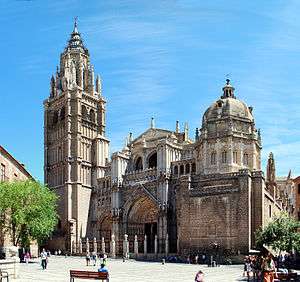Cuenca Cathedral
| Cuenca Cathedral Catedral de Santa María y San Julián de Cuenca | |
|---|---|
|
Façade of the cathedral | |
| Basic information | |
| Location | Cuenca, Spain |
| Affiliation | Catholic Church |
| Architectural type | Church |
| Architectural style | Gothic |
Cuenca Cathedral is a Gothic cathedral in the city of Cuenca in Cuenca Province in the Castile-La Mancha region of south-eastern central Spain. Expression of Norman Gothic of northern Europe, begun in 1196. The wife of King Alfonso VIII, Eleanor Plantagenet of England, daughter of King Henry II Plantagenet of England and Eleanor of Aquitaine, Duchess of Aquitaine, Sister of Richard the Lionheart, who inspired this cathedral. The influence of the Norman court of King Alfonso VIII, defined the construction of this cathedral, the first Gothic cathedral of Castile, together with that of Avila. Work began in the year 1196 and was completed in 1257.
The highlight of the building is that belongs to a very initial approach of the Gothic architecture, closely related to Anglo-Norman and French-Norman art of 12th century, as the Soissons Cathedral, Laon Cathedral and Notre Dame de Paris.
It has a Latin cross plan (that is, the arm of the cross reaching from the main entrance to the altar is considerably longer than the other arms) and a seven-sided polygonal apse.[1] The main facade was lowly restored by Vicente Lampérez in the early twentieth century.
The cathedral is officially the Basílica de Nuestra Señora de Gracia ("Basilica of Our Lady of Grace").[1] Unlike many other cathedrals in Spain, photography is not normally allowed in the interior.
History

On September 21, 1177, Alfonso VIII of Castile "The Noble" conquered the city of Cuenca and is constituted as bishopric seat in the year 1183. It was built on the ancient main Muslim mosque in the city.
The King Don Alfonso, made and ordered that the mosque that the Moors had, commanded the bishops who consecrate themselves ... and put his hand by the Virgin Mary that even if it had, and passed and moved the bishoprics of Valeria and Arcas and put the chair in the his city of Cuenca.
Inspires the construction of the Cathedral, the wife of Alfonso VIII, Leonor of England or Plantagenet, daughter of King Henry II Plantagenet of England and Eleanor of Aquitaine, Duchess of Aquitaine and sister of Richard the Lionheart. For her dowry, Eleanor of England or Plantagenet, Countess of Gascony, is accompanied by Norman knights who will be those who will exercise their influence over the factory of the cathedral. At this time, the building style was the Romanesque, but the Norman influence of the court of King Alfonso VIII decided to build this cathedral, the first Gothic cathedral in Castile, along with the Ávila. Of Gothic style linked to the masters of the French Champagne, the works began in the year 1196 and was completed in the year 1257. However, like most religious buildings, has suffered transformations over the centuries: in the 15th century the Gothic sanctuary was rebuilt, the exterior of the cathedral was renovated in the 16th century and in the 17th century it built the chapel of the Tabernacle and it reformed the facade and the towers, in a Baroque style. In the 18th century the new main altar was built.
Due to a lightning strike on the cathedral came the collapse of the Tower of the Giraldo, which took place on April 13, 1902, along came the outcome of the death of four young, being alive three children among rubble, then it made a lowly restoration of its facade. However, now remain the plans of restore the lost sections the Cathedral once it reach an integral architectural approach.
Gallery
 Cathedral of Cuenca before the 1902 lightning strike and subsequent lowly restoration of the facade.
Cathedral of Cuenca before the 1902 lightning strike and subsequent lowly restoration of the facade.
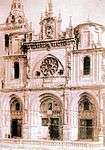 Facade of the Cathedral of Cuenca before 1902.
Facade of the Cathedral of Cuenca before 1902.
Hidden Mysteries at the Cathedral of Cuenca
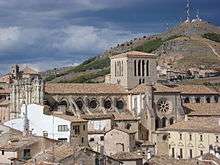
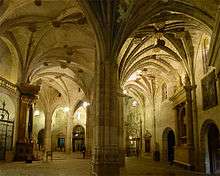
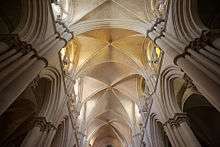
Legend says that this will be the only stronghold Cathedral for the Salvation of the desperate end of the day predicted by Nostradamus in his "centuries". So it tells Rodrigo de Luz, scholar and architect linked to Cuenca Cathedral.
Rodrigo de Luz says that within this temple was saved and preserved the Holy Grail, which is why the Cathedral of Cuenca, in the final cataclysm will not be destroyed and all those who take refuge within its ancient walls. From reading the books of Revelation and the Centuries of Nostradamus, the researcher conclude that the two texts refer to the temple that at the end of the times will receive their salvation.
Stressing the similarities of Cuenca and the New Jerusalem of the books of Revelation, the New Jerusalem will have a pass of salvation, "with 12 gates; in the 12 doors, 12 angels".
The Cathedral of Cuenca fits in this comparison, 12 gates in shape of bows, each of which has 12 angels, just as indicated in the book of Revelation, as a curiosity, the 12 stone angels were sculpted with a serious face and her hands hold a book, all but one, who is smiling happily and holding in his hands a Cup, thinking that this shows part of the legend of the Holy Grail hidden and the Mystery of the Cathedral of Cuenca, where some speculate that this secretly hidden the Holy Grail.
There's more hidden messages in the Cathedral and City of Cuenca and is the Mystery of the shield of arms of the city of Cuenca, is a shield of great simplicity, interestingly the shield contains a cup, and the cup, featured a 8 pointed star, symbol of the Templars.
Some features that remain to this day
The cathedral was consecrated by Saint Julian of Cuenca, second bishop of Cuenca, in the year 1196 when it was still in its beginning.
The Cathedral was started by French stonemasons between the years 1182 and 1189 (12th century) continuing the works throughout the 13th century. The Cathedral was built on the ancient Muslim mosque in the city.
It is considered the first Gothic cathedral made in Castile, being finally consecrated under the invocation of Saint Mary in 1208 by Bishop Rodrigo Ximénez de Rada.
However, the construction of the cathedral began in the late Romanesque, so it is natural that it find Romanesque resistances against the new Gothic of the moment.
Initially, began with a header rather Romanesque, with five staggered apses, transept and three naves in the main body.
The initial plan of the cathedral was made up of three naves; at the height of the cruise it was transformed into five naves and still forming five apses, following the traces of the prevailing Romanesque.
The works were developed in the 13th century that the clerestory was built, with molded windows and decorated with statues of angels and a superior oculus. The vaults are sexpartite ribbed.
In the 15th century was rebuilt the header to open a double ambulatory of beautiful invoice. As for the interior should be noted that in the 17th century the chapter of the cathedral claimed the services of the architect Ventura Rodríguez to raise a Transparent (window glass that illuminates and decorates the background of an altar) that rival with raised by Narciso Tomé in the Cathedral of Toledo. Rodríguez it placed in a Gothic ambulatory, so that shine through the rear and indirect lighting, through which spectacular effects are achieved.
The cruise is covered by a large central vault of Anglo-Norman influence.
In the 18th century the new altar was built, whose statues of the altarpiece is due to the work of Pasquale Bocciardo and, since the early 20th century due to the collapse of the tower Giraldo, was very poorly restorated the facade by Vicente Lampérez. However, now remain the plans of restore the lost sections of the Cathedral once it reach an integral architectural approach.
The latest interventions to the date have been the complete restoration of the cloister of the 16th century.
Iconography
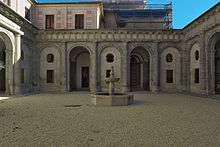
Coinciding the Discovery of America, in 1492, during the development of the work made that were sculpted in it native animals of the newly discovered lands making the Cuencan iconography special and different from other cathedrals.
Given these concepts, the iconography featuring the Cathedral of Cuenca is of fantastic type, mythological and human figures, interspersed among them icons such as plant leaves, stems, fruits and meandering stems along the stems. However, what really sets it apart from the rest, are those animals without being known in the West are present in its Gothic arches of the late 15th century, such as the armadillo, the puffer fish and turtle.[2]
| Wikimedia Commons has media related to Cathedral of Cuenca. |
See also
References
- 1 2 Catedral de Nuestra Señora de Gracia - Nuestra Señora de Gracia Cathedral, www.spain.info.
- ↑ José María Rodríguez González (2012). Animal Iconography in the Middle Ages. A singular and unique world in the arcades of Cuenca Cathedral: Journal of Feelsynapsis.JoF. ISSN 2254-3651. Number 4. Pages 40-50.
Bibliography
- "Cathedral of Cuenca". www.arteguias.com/ (in Spanish). 2004. Retrieved February 5, 2007.
- "Cathedral of Cuenca". www.arsvirtual.com/ (in Spanish). 2006. Archived from the original on March 24, 2006. Retrieved February 5, 2007.
- "The Cathedral of Cuenca". www.uv.es/ (in Spanish). Retrieved February 5, 2007.
External links
Coordinates: 40°04′43″N 2°07′44″W / 40.07849°N 2.12901°W

